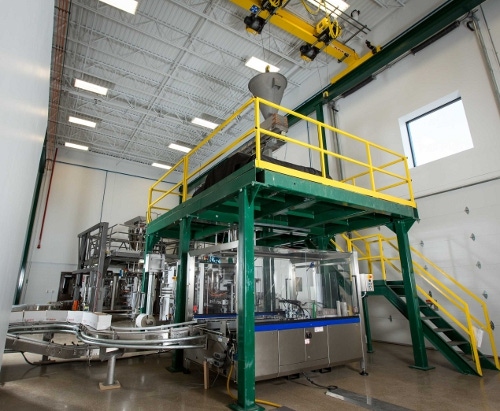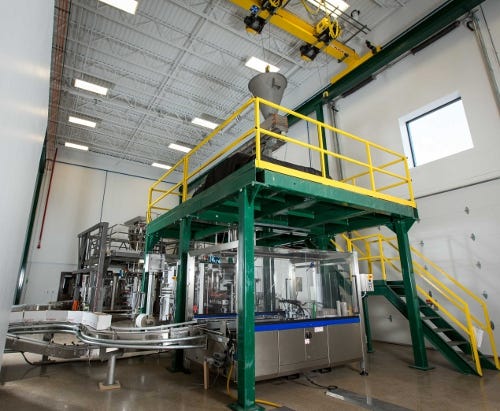
Photo Disclaimer: The images shown are representative of various points made in this article and are not actual operations in a ConAgra facility.
Packaging is the last step between processing ready-to-eat (RTE) foods and the consumer. As such, everything that happens in and around the packaging step is critical to providing consumers with safe food. So we concentrate on areas where packaging occurs in contact with the food—known as the "Product Zone."
In considering what constitutes the product zone, packaging machinery specifications can help maximize food safety for our consumers. Specifications need to clearly explain to equipment vendors what is required from a food safety point of view.
Touch points
The impact of regulations is changing how food packagers look at sanitary design criteria. The Food Safety Modernization Act (FSMA) is beginning to blur some of the boundaries between washdown and non-washdown areas. Previously, washdown was a specific set of criteria in a specific area. Packaging of dry produced goods was not often considered for washdown clean up. But as we look at FSMA, a hazards analysis shows those points where all contaminations can potentially come from—and that's not necessarily just from a product-contact surface.
Current industry practice is to focus on the product-contact surface. Where does the food touch? What does it touch? How does it get there? Contaminations may potentially enter from many other points than just the product-contact surface. So the product zone is now where we're driving our definitions for specification. In the product zone, the focus was primarily on product-contact surfaces but now requirements drive focusing on the entire environment around an open process.
We've concentrated on five types of hazards that can affect how contaminants may potentially enter into the processed food: contact-surface hazards, overhead hazards, proximity hazards, potential transfer hazards and environmental hazards. Let's look at each one.
1. Contact-surface hazards
Contact-surface hazards were already in the forefront of industry's minds. Here, the focus is on what's touching the product. Is it stainless steel, plastic or something else?
Is the surface going to be readily cleanable? Is it accessible for cleaning? Accessibility is one of the main considerations in an equipment design. The surface may be good but if it can't be cleaned, it is still going to have a surface that's imparting contaminants into the product. Cracks, crevices, sharp corners-all these places can hide, grow and impart bacteriological contaminations. Welds need to be ground smooth, polished and radiused so there's no place for bacteria build up.
Packaging materials are a contact surface. Any machine, say a bagger or cartoner, that touches the interior of that package has the ability to impart contaminants into the food that goes in it. So we all need to look at such things as rollers on a dancer bar. Those rollers need to be a solid, clean, polished surface, not hollow where contaminants can harbor and then leak out at a different point in time. We also need to look at box formers, plungers, suction cups, denesters. If it's touching the inside of a container, that contact could impart a contaminant and the specifications need to be spelled out to equipment vendors to prevent contaminations from these sources.

ConAgra food safety mchy specs
2. Overhead hazardsAnother potential hazard comes from overhead where contaminants can build up and then fall into a product. This includes areas outside and inside of a packaging machine. Outside the system, we've focused on pipes, conduits, cable, cords, ceilings, light fixtures and other things that are above the product in an open packaging line. Is there a place where things could leak and drip into the equipment and is the equipment protected from such leaks?
Look at hazards within the equipment, too, and specify designs that highly reduce any risk from things such as fans, cabling, air lines and auxiliary equipment within the enclosure. Are these places that can build up material on them and, at some point, could that material release and drop onto the package material, say in a bagger? For example, is there an overhead printer that's mounted horizontally versus vertically, where material will build up and then vibrate off and drop onto the film that creates a package? Does that now become a contaminated surface exposed to the food?
Cabling, for example, needs to be spaced out so that contaminants don't have a place to sit between bundled air lines or bundled cables. Conveyor discharge points become an overhead hazard where one conveyor discharges onto another. Bearings can leak grease. Sprockets can build up dirt. These contaminants can drop out onto the product or onto the product-contact surface of the belt below.
3. Proximity hazards
Proximity hazards—such as guide rails and sidewalls—are becoming rather significant in the examination of contamination hazards. Is there build-up on the interior of a cabinet and, as such, when there's air motion or fans blowing air, is that material moving and falling onto the product? Is something going on in a nearby piece of equipment that has a discharge, a spray of water or air, or some kind of contaminant that could be migrating its way over to the packaging equipment?
Also consider support structures within the equipment. Is there a good base, but a frame that builds up material or holds water? Are there holes in a tubular frame that will drip something onto the product? There are many guards for instrumentation that can harbor contaminants and then those can drop off or migrate into open food or other surfaces.
4. Potential transfer hazards
In the past, industry, in general, hasn't thought too much about potential transfer hazards. But there have been a number of instances within the food industry where contamination has happened through a transfer from conduit, cables, cords or other structural elements that are below or close to the open product.
For example, if maintenance personnel have to crawl underneath something to work on it, how much dust, dirt or acquired debris are they getting into that's laying on the support structure, laying on underneath cables? As they stand up, they may put their hand on the product-contact surface, say a conveyor, or somewhere near the product-contact surface. Now there is the distinct possibility that Listeria or other such contaminants that weren't in the product zone or were below the product zone have now been transferred into the the product zone and contaminated the product. There are documented cases of this having happened. These are things to think about, even in what would usually be considered a non-washdown area.
Is there proximity to a raw product process or to waste sources where cross-contamination is possible? Is the packaging line open next to a trash dock where contaminated material, either through transfer in the air or by things falling off of carts, create a risk?
One of the areas that hasn't really been thought about too much, as the industry is moving further into the use of robotics, is end-of-arm tooling that may be moving between environments. What might it be transferring?
5. Environmental hazards
Lastly, as a creator of specifications, do perform an analysis of environmental risk. What can contaminate the product from the air? Where can things come from and what can be done to mitigate the risk with shielding, guarding or air management? Is a pressurized cabinet required? Is evacuation required? Is there a vacuum to extract contaminants that could be in the air? Is modified atmosphere inside the packaging machine able to help keep contaminants out?
What about radiological issues? Where are the sources and how do processors protect food from those sources?
In summary
We all need to assess our hazards and write our packaging machinery specifications to thoroughly mitigate them. Vendors, use this information to ask your customers what hazards they see or expect so that you can do a better job of designing the equipment for them.
Mike Brusky has been with ConAgra since 1998 and works in the corporate engineering department for the Consumer Foods Group. His 30 years of engineering experience in the food industry includes both processing and packaging equipment. He is currently updating the company's specifications for packaging machinery as they relate to food safety.
.
About the Author(s)
You May Also Like


